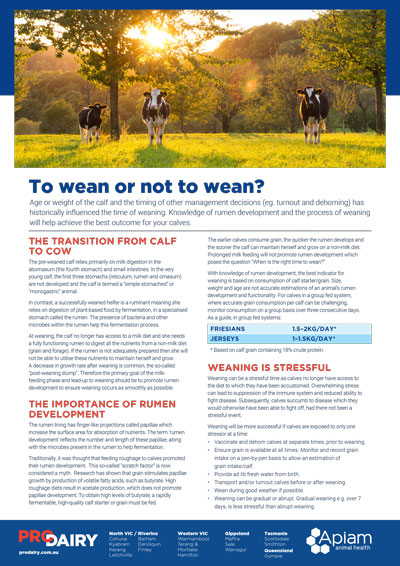Age or weight of the calf and the timing of other management decisions (eg. turnout and dehorning) has historically influenced the time of weaning. Knowledge of rumen development and the process of weaning will help achieve the best outcome for your calves.
THE TRANSITION FROM CALF TO COW
The pre-weaned calf relies primarily on milk digestion in the abomasum (the fourth stomach) and small intestines. In the very young calf, the first three stomachs (reticulum, rumen and omasum) are not developed and the calf is termed a “simple stomached” or “monogastric” animal.
In contrast, a successfully weaned heifer is a ruminant meaning she relies on digestion of plant-based food by fermentation, in a specialised stomach called the rumen. The presence of bacteria and other microbes within the rumen help this fermentation process.
At weaning, the calf no longer has access to a milk diet and she needs a fully functioning rumen to digest all the nutrients from a non-milk diet (grain and forage). If the rumen is not adequately prepared then she will not be able to utilise these nutrients to maintain herself and grow.
A decrease in growth rate after weaning is common, the so-called “post-weaning slump”. Therefore the primary goal of the milk-feeding phase and lead-up to weaning should be to promote rumen development to ensure weaning occurs as smoothly as possible.

THE IMPORTANCE OF RUMEN DEVELOPMENT
The rumen lining has finger-like projections called papillae which increase the surface area for absorption of nutrients. The term ‘rumen development’ reflects the number and length of these papillae, along with the microbes present in the rumen to help fermentation.
Traditionally, it was thought that feeding roughage to calves promoted their rumen development. This so-called “scratch factor” is now considered a myth. Research has shown that grain stimulates papillae growth by production of volatile fatty acids, such as butyrate. High roughage diets result in acetate production, which does not promote papillae development. To obtain high levels of butyrate, a rapidly fermentable, high-quality calf starter or grain must be fed.
The earlier calves consume grain, the quicker the rumen develops and the sooner the calf can maintain herself and grow on a non-milk diet. Prolonged milk feeding will not promote rumen development which poses the question
“When is the right time to wean?”
With knowledge of rumen development, the best indicator for weaning is based on consumption of calf starter/grain. Size, weight and age are not accurate estimations of an animal’s rumen development and functionality. For calves in a group fed system, where accurate grain consumption per calf can be challenging, monitor consumption on a group basis over three consecutive days.
As a guide, in group fed systems:FREISANS 1.5–2KG / DAY*
jerseys 1–1.5 KG / DAY*
*Based on calf grain containing 18% crude protein.
WEANING IS STRESSFUL
Weaning can be a stressful time as calves no longer have access to the diet to which they have been accustomed. Overwhelming stress can lead to suppression of the immune system and reduced ability to fight disease. Subsequently, calves succumb to disease which they would otherwise have been able to fight off, had there not been a stressful event.
Weaning will be more successful if calves are exposed to only one stressor at a time:
- Vaccinate and dehorn calves at separate times, prior to weaning.
- Ensure grain is available at all times. Monitor and record grain intake on a pen-by-pen basis to allow an estimation ofgrain intake/calf.
- Provide ad lib fresh water from birth.
- Transport and/or turnout calves before or after weaning.
- Wean during good weather if possible.
- Weaning can be gradual or abrupt. Gradual weaning e.g. over 7 days, is less stressful than abrupt weaning.
